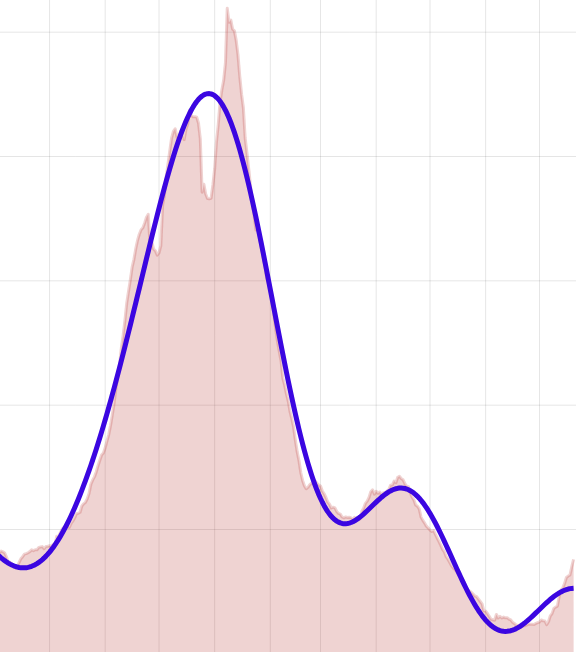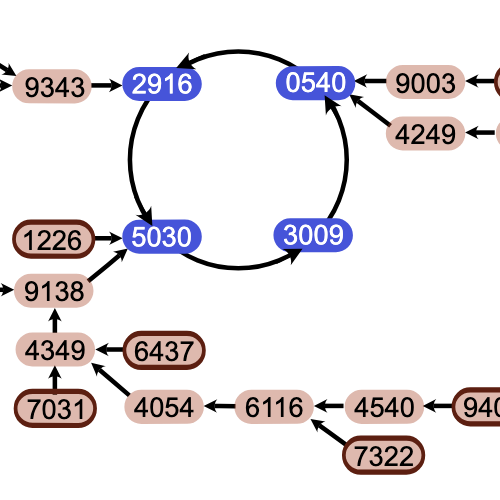Twenty-Six Twiddles Suffice
by Brian Hayes
Published 4 June 2007
Among the 250 million Rubik’s cubes manufactured since 1980, how many lie abandoned in a scrambled state, having never regained their original configuration since being taken out of the box? Most of them, I would guess. Now comes word that those cubes might be restored to pristinity with a little less effort. The upper bound on the number of moves required to solve any state of Rubik’s cube has been lowered from 27 to 26. The result is reported by Daniel Kunkle and Gene Cooperman of Northeastern University in a preprint available here.
It’s well-known that Rubik’s cube isn’t really a toy or a puzzle but rather a group-theory machine in disguise. Each possible move, or twiddle—rotating a face by some multiple of 90 degrees—is a transformation that permutes the positions and orientations of the 26 “cubies.” From any position there are just 18 distinct nontrivial moves, but in various combinations they generate a total of 43,252,003,274,489,856,000 permutations. What is the maximum number of moves needed to transform any one state of the cube into any other? That’s the question Kunkle and Cooperman are addressing. In other words, they are looking for the longest shortest path.
In principle we could get the answer by exhaustive search. It would be done by constructing the “Cayley graph” for the Rubik group: a graph in which each possible configuration of the cube is represented by a node, and two nodes x and y are connected by an edge if some single move allows configuration x to be transformed into y. The most efficient solution for any state is the shortest path (i.e., sequence of edges) leading from that state to the node representing the solved state. The worst-case solution length for the entire puzzle is the maximum of the shortest solution paths for all the nodes. The Cayley graph approach was used by Cooperman and two colleagues to find the worst-case path for the 2 × 2 × 2 version of Rubik’s cube. The Cayley graph for this device has 88,179,840 nodes, and it turns out the longest paths within it have 11 steps. For the 3 × 3 × 3 cube, however, exhaustive search is just too exhausting.
To make the search feasible, Cubists have had to scale back their ambitions and accept an upper bound rather than a true maximum. First it was shown that the worst-case solution path cannot require more than 52 moves; then the bound was lowered to 30, and then 29; a year ago Silviu Radu got the number down to 27.
Kunkle and Cooperman’s strategy is to factor the problem into two pieces by segregating half-turn (180-degree) and quarter-turn (±90-degree) moves. The subgroup of states reachable by half-turn moves is quite small by Rubik group standards, with just 663,552 elements, and the number is further reduced to only 15,752 after various symmetries are eliminated. Calculating the best solution for each of these states took only about a day on an ordinary PC. The longest such paths have 13 steps.
The second phase of the analysis tackles the “cosets” of the half-turn subgroup. For each of the 663,552 positions reachable by making half-turns only, there are 65,182,537,728,000 additional positions reachable by making quarter-turn moves. Kunkle and Cooperman had to search for the longest shortest path connecting any two elements of this set. They exploited various symmetries to reduce the scope of the problem and devised fast algorithms for some of the basic steps in the calculation. Even so, they wound up running their computer program for 63 hours on 128 processors at the San Diego Supercomputer Center. At one point the data store for intermediate results ballooned to seven terabytes. At the end of the run, they found that the longest shortest path consisted of 16 moves.
Combining the two phases of this solution yields 13 moves for the half-turn part of the path and 16 moves for the coset part, for a total of 29 moves. This is not an improvement over the best existing result of 27. However, Kunkle and Cooperman found that the two-stage algorithm reports path lengths greater than 26 only for a comparative handful of states—about 14,000. By a brute-force search they were able to find solutions of length 26 or less for each of these states, and thereby established the 26-move bound overall. It’s possible that further brute-force searching will lower the limit further to 25 moves.
Other experiments done by Herbert Kociemba, Richard Korf and others have shown that most randomly selected cube states can be solved in 18 moves or less. Korf has conjectured that all configurations are solvable in about 20 steps. We’ll see whether this is true—but probably not soon.
Publication history
First publication: 4 June 2007
Converted to Eleventy framework: 22 April 2025

